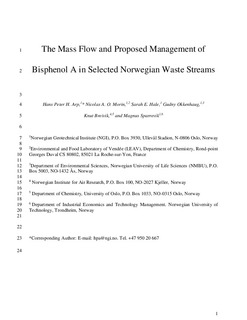| dc.contributor.author | Arp, Hans Petter Heinrich | |
| dc.contributor.author | Morin, Nicolas | |
| dc.contributor.author | Hale, Sarah | |
| dc.contributor.author | Okkenhaug, Gudny | |
| dc.contributor.author | Breivik, Knut | |
| dc.contributor.author | Sparrevik, Magnus | |
| dc.date.accessioned | 2018-03-07T13:00:40Z | |
| dc.date.available | 2018-03-07T13:00:40Z | |
| dc.date.created | 2017-01-16T09:26:09Z | |
| dc.date.issued | 2017 | |
| dc.identifier.citation | Waste Management. 2017, 60 775-785. | nb_NO |
| dc.identifier.issn | 0956-053X | |
| dc.identifier.uri | http://hdl.handle.net/11250/2489252 | |
| dc.description.abstract | Current initiatives for waste-handling in a circular economy favor prevention and recycling over incineration or landfilling. However, the impact of such a transition on environmental emissions of contaminants like bisphenol A (BPA) during waste-handling is not fully understood. To address this, a material flow analysis (MFA) was constructed for selected waste categories in Norway, for which the amount recycled is expected to increase in the future; glass, vehicle, electronic, plastic and combustible waste. Combined, 92 tons/y of BPA are disposed of via these waste categories in Norway, with 98.5% associated with plastic and electronic waste. During the model year 2011, the MFA showed that BPA in these waste categories was destroyed through incineration (60%), exported for recycling into new products (35%), stored in landfills (4%) or released into the environment (1%). Landfilling led to the greatest environmental emissions (up to 13% of landfilled BPA), and incinerating the smallest (0.001% of incinerated BPA). From modelling different waste management scenarios, the most effective way to reduce BPA emissions are to incinerate BPA-containing waste and avoid landfilling it. A comparison of environmental and human BPA concentrations with CoZMoMAN exposure model estimations suggested that waste emissions are an insignificant regional source. Nevertheless, from monitoring studies, landfill emissions can be a substantial local source of BPA. Regarding the transition to a circular economy, it is clear that disposing of less BPA-containing waste and less landfilling would lead to lower environmental emissions, but several uncertainties remain regarding emissions of BPA during recycling, particularly for paper and plastics. Future research should focus on the fate of BPA, as well as BPA alternatives, in emerging reuse and recycling processes, as part of the transition to a circular economy. | nb_NO |
| dc.language.iso | eng | nb_NO |
| dc.publisher | Elsevier | nb_NO |
| dc.rights | Attribution-NonCommercial-NoDerivatives 4.0 Internasjonal | * |
| dc.rights.uri | http://creativecommons.org/licenses/by-nc-nd/4.0/deed.no | * |
| dc.title | The mass flow and proposed management of bisphenol A in selected Norwegian waste streams | nb_NO |
| dc.type | Journal article | nb_NO |
| dc.type | Peer reviewed | nb_NO |
| dc.description.version | acceptedVersion | nb_NO |
| dc.source.pagenumber | 775-785 | nb_NO |
| dc.source.volume | 60 | nb_NO |
| dc.source.journal | Waste Management | nb_NO |
| dc.identifier.doi | 10.1016/j.wasman.2017.01.002 | |
| dc.identifier.cristin | 1427796 | |
| dc.relation.project | Norges forskningsråd: 221440 | nb_NO |
| dc.description.localcode | © 2017. This is the authors’ accepted and refereed manuscript to the article. Locked until 13.1.2019 due to copyright restrictions. This manuscript version is made available under the CC-BY-NC-ND 4.0 license http://creativecommons.org/licenses/by-nc-nd/4.0/ | nb_NO |
| cristin.unitcode | 194,60,25,0 | |
| cristin.unitname | Institutt for industriell økonomi og teknologiledelse | |
| cristin.ispublished | true | |
| cristin.fulltext | postprint | |
| cristin.qualitycode | 1 | |

